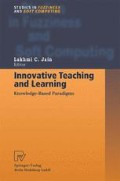Abstract
To learn new concepts and algorithms requires an analytical mind and intensive conceptual thinking. With the illustration of appropriate applications and teaching tools, it will assist and enhance the learning ability.
Access this chapter
Tax calculation will be finalised at checkout
Purchases are for personal use only
Preview
Unable to display preview. Download preview PDF.
References
Chung, C.C. and Kumar, V.R. (1993), “Knowledge Acquisition using a Neural Network for a Weather Forecasting Knowledge-based System;” Neural Computing and Applications, No. 1, pp. 215–223.
Davies, E.R. (1990), Machine Vision: Theory, Algorithms, Practicalities, Academic Press Ltd.
Dubois, D. and Prade, H. (1981), Fuzzy Sets and Systems: Theory and Applications, Academic Press.
Enbutsu, L., Baba, K., and Hara, N. (1991), “Fuzzy Rule Extraction from a Multilayered Neural Network,” Int. Joint Conference on Neural Networks (IJCNN’91), Singapore.
Fausett, L. (1994), Fundamentals of Neural Networks: Architectures, Algorithms, and Applications, Prentice Hall Inc.
Goldberg, D.E. (1989), Genetic Algorithms in Search, Optimization and Machine Learning, Addison-Wesley.
Janikow, C.Z. (1994), “Learning Fuzzy Controllers by Genetic Algorithms,” Proceedings 1994 ACM Symp. On Applied Computing, ACM Press, New York.
Klir, G.J. and Folger, T.A. (1982), Fuzzy Sets, Uncertainty, and Information, Prentice Hall.
Kosko, B. (1992), Neural Networks and Fuzzy Systems: A Dynamical Systems Approach to Machine Intelligence, Prentice Hall Inc.
Lee, R.S.T. and Liu, J.N.K. (1999), “An Automatic Satellite Interpretation of Tropical Cyclone Patterns Using Elastic Graph Dynamic Link Model,” International Journal of Pattern Recognition and Artificial Intelligence, (to appear).
Lee, R.S.T. and Liu, J.N.K. (1999), “An Oscillatory Elastic Graph Matching Model for Scene Analysis,” Proceedings of International Conference on Imaging Science, Systems, and Technology (CISST’99), June 28-July 1, Monte Carlo Resort, Las Vegas, Nevada, U.S.A.
Li, B., Liu, J. and Dai, H. (1998), “Forecasting from Low Quality Data with Applications in Weather Forecasting,” Int. Journal of Computing and Informatics, Vol. 22, No. 3, pp. 351–358.
Liu, N.K. (1988), Computational Aspects of a Fine-mesh Sea Breeze Model, M. Phil. Dissertation, Department of Mathematics, Murdoch University, Western Australia.
Liu, N.K. and Lee, K.K. (1997), “An Intelligent Business Advisor for Stock Investment,” Expert Systems, Vol. 14, No. 3, Blackwell Publishers, U.K., pp. 129–139.
Liu, J.N.K. and Lee, R.S.T. (1999), “Rainfall Forecasting from Multiple Point Sources Using Neural Networks,” Proceedings of IEEE International Conference on Systems, Man, and Cybernetics (SMC’99), October 12–15, Tokyo, Japan (to appear).
Liu, J.N.K. and Lee, R.S.T. (1998), “Invariant Handwritten Chinese Character Recognition by Dynamic Link Architecture,” Proceedings ICONIP/JNNS’98, Vol. 1, pp. 275–278, Kitakyushu, Japan.
Liu, J.N.K. and Sin, K.Y. (1997), “Fuzzy Neural Networks for Machine Maintenance in Mass Transit Railway System,” IEEE Trans. on Neural Networks, Vol. 8, No. 4, pp. 932–941.
Liu, J.N.K. and Tang, T.I. (1996), “An Intelligent System for Financial Market Prediction,” Proceedings of the 2nd South China International Business Symposium, pp. 199–209, Macau.
Liu, J. and Wong, L. (1996), “A Case Study for Hong Kong Weather Forecasting,” Proceedings of Int. Conference on Neural Information Processing, pp. 787–792, Hong Kong.
Luger, G.F. and Stubblefield W.A. (1993), Artificial Intelligence: Structures and Strategies for Complex Problem Solving, 2nd Edition, Benjamin Cummings Publishing Company Inc.
McCulloch, W.S. and Pitts, W. (1943), “A Logical Calculus of the Ideas Immanent in Nervous Activity,” Bulletin of Mathematical Biophysics, No. 5, pp. 115–133.
McGregor, J.L., Walsh, K.J. and Katzfey, J.J. (1993), “Climate Simulations for Tasmania,” Fourth Int. Conference on Southern Hemisphere Meteorological and Oceanography, American Meteorological Society, pp. 514–515.
Pal, S.K. and Wang, P.P. (1996), Genetic Algorithm for Pattern Recognition, CRC Press.
Silvermann, H. and Bernstein, R. (1971), “Digital Techniques for Earth Resource Image Data Processing,” Proceedings of the American Institute of Aeronautics and Astronautics, Vol. 21, pp. 455–468.
Slezak, E., Bijaoui, A. and Mars, G. (1990), “Structures Identification from Galaxy Counts: Use of the Wavelet Transform,” Astronomy and Astrophysics, Vol. 227, pp. 301–316.
Widrow, B. and Smith, F.W. (1963), “Pattern-Recognition Control Systems,” Proceedings of Computer and Information Science Symposium, Spartan Books, Washington, DC, U.S.A.
Wong, F., Wang. P.Z. and Goh. T.H. (1991), “Fuzzy Neural Systems for Decision Making,” Proceedings of the Int. Joint Conference on Neural Networks (IJCNN’91), Singapore.
You, J., Liu, J. and Lee, R. (1999), “An Image Matching Approach to Tropical Cyclone Pattern Recognition,” Proceedings of International Conference on Imaging Science, Systems, and Technology (CISST’99), June 28-July 1, Monte Carlo Resort, Las Vegas, Nevada, U.S.A.
Author information
Authors and Affiliations
Editor information
Editors and Affiliations
Rights and permissions
Copyright information
© 2000 Springer-Verlag Berlin Heidelberg
About this chapter
Cite this chapter
Lee, R.S.T., Liu, J.N.K. (2000). Teaching and Learning the AI Modeling. In: Jain, L.C. (eds) Innovative Teaching and Learning. Studies in Fuzziness and Soft Computing, vol 36. Physica, Heidelberg. https://doi.org/10.1007/978-3-7908-1868-0_2
Download citation
DOI: https://doi.org/10.1007/978-3-7908-1868-0_2
Publisher Name: Physica, Heidelberg
Print ISBN: 978-3-7908-2465-0
Online ISBN: 978-3-7908-1868-0
eBook Packages: Springer Book Archive

